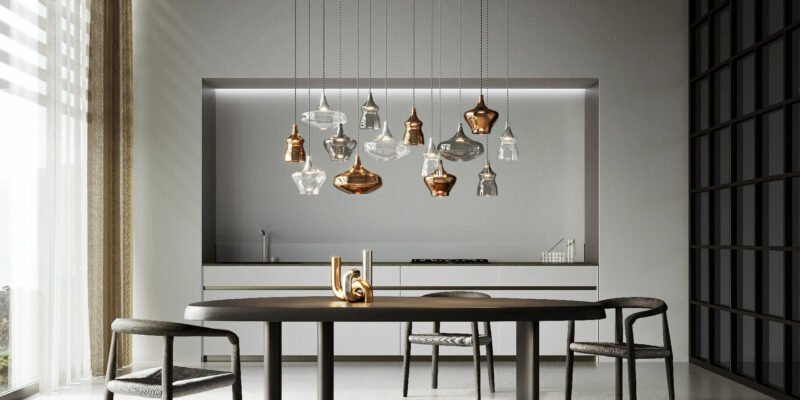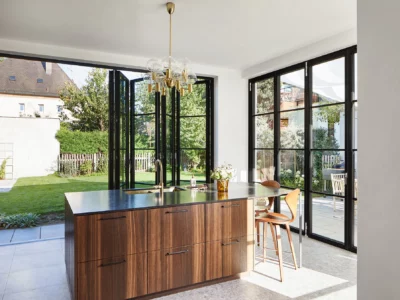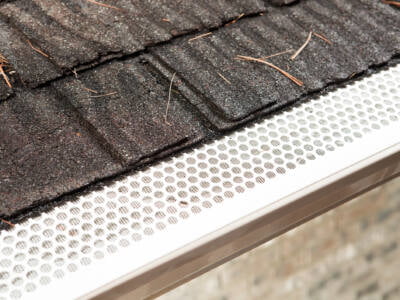If you’d like to update the lighting in your home but are looking to avoid the hassle of messy electrical work, switching up your lamp shades can be a simple yet transformative place to start. However, if you live in a more traditional home that still retains its original characteristics or even a modern property with more classic features, you may find yourself contending with older style fixtures such as chandeliers and even chandelier lamp shades.
Bringing a sense of ambience to both traditional and contemporary properties alike, chandeliers are the decorative and aesthetically classic option on the market when it comes to lighting your home. Historically seen as a symbol of wealth and decadence, chandeliers have become more accessible and widespread since the invention of gas and electric lighting. However, they still raise the age-old question – should chandeliers be left bare, or have lamp shades, and what even is a chandelier anyway?
What is a chandelier?
A chandelier is an ornamental light fixture designed to be mounted on an interior ceiling or wall. It is most commonly seen as the main light in the centre of a room, where it usually acts as an ornate focus point. These days, a modern chandelier often has several branches with a lightbulb at the end of each branch. Visually similar to a large oak tree, chandeliers traditionally featured hanging crystal prisms that illuminated interior spaces with soft, refracted light for a truly luxurious glow.
What is the history of a chandelier?
Chandeliers were invented during the medieval period more than 500 years ago and evolved from the classic candelabra. Historically, chandeliers used candles as a source of light – so in a way, a chandelier is almost like a hanging candelabra. Candles were used to illuminate chandeliers until the 18th century when the invention of gas lights, and later electricity, superseded the need for candle lighting.
The largest chandelier in the world is the crystal chandelier located in the Dolmabahçe Palace in Istanbul, the largest palace in Turkey. The chandelier weighs 4.5 tons and has 750 lamps. Originally, it was thought to have been a gift from Queen Victoria herself but this was later disproven.
Although chandeliers were a status symbol for hundreds of years, the invention of gas and electrical lighting has made them more accessible and widespread in recent years. Modern chandeliers utilise electric light and unlike their traditional predecessors, often do not feature the hanging crystal prisms typical of an older style. In this day and age, chandeliers come in a variety of different styles and colours. Chandelier lamp shades in particular have become increasingly popular in recent years and are revered for their innate ability to redirect the bright, often overwhelming, light that can result from a chandelier fixture.
Chandelier lamp shades
As the name suggests, a chandelier lamp shade is a decorative covering around one of the many branches of a traditional chandelier. While older style chandeliers feature candles, modern chandeliers often have several branches with a lightbulb on each. Chandelier lamp shades work to reduce the brightness of the lightbulb, as well as transform the ambience of a room by controlling how the light shines and bounces around the room.
Also known as diffusers, these days the use of modern chandelier lamp shades is largely based on the personal preferences and tastes of the homeowner. A chandelier can cast uncomfortably bright light around a room without lamp shades, as it is a multi-bulb fixture. This may stem from the original function of a chandelier that utilised soft candlelight and crystal prisms to illuminate a room instead of modern electric lighting.
In terms of combining functionality, modern convenience and traditional aesthetics, chandelier lamp shades make perfect sense. The use of lamp shades can soften and redirect the light, bringing a sense of cosy ambience into a room. It’s also important to note that without lamp shades, a chandelier can appear unfinished – but the wrong type of lamp shades can also transform a classic chandelier into a cluttered and visually unappealing fixture. This is where the unique specifications of your interior living spaces come into play as well as the chandelier in question. Your own personal tastes should also be taken into account.
Styles of chandelier lamp shades
At the end of the day, deciding to add lamp shades to your chandelier will come down to your own personal taste. Fortunately, there are many styles of chandelier lamp shades to choose from to suit a variety of different preferences and aesthetics.
- Traditional – As the name would suggest, a traditional chandelier lamp shade is an older, more classic style, and often features silk or cotton dupion, pleats and/or ribbon wrap with a traditional trim.
- Modern – A modern lamp shade is a more contemporary style of chandelier lamp shade and is made from your choice of cotton, parchment, linen, taffeta or silk dupion.
- Ribbon – Similar in appearance to a ribbon wrap, a ribbon-style chandelier lamp shade gives your lamp shades a pleated effect and can project stunning shapes within your interior living spaces.
Final thoughts
Chandeliers are the decorative and visually classic option on the market when it comes to lighting your home, bringing a sense of ambience and bygone era-esque aesthetics to both traditional and contemporary properties alike.
At the end of the day, the decorative decisions you make for your interior lighting will come down to the unique specifications of your property as well as your own unique tastes. However, if you want to alter your home’s lighting but don’t want to deal with the inconvenience of messy electrical work, changing out your lamp shades is a great place to start. Also known as diffusers, chandelier lamp shades can transform your interior living spaces and create a sense of ambience by redirecting and softening the light.










Comments